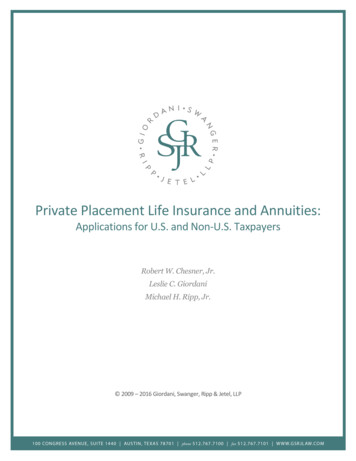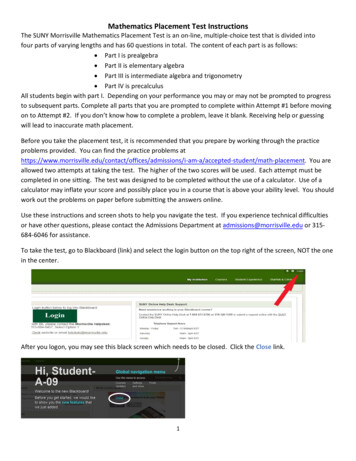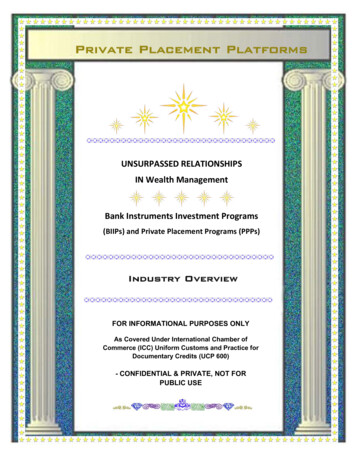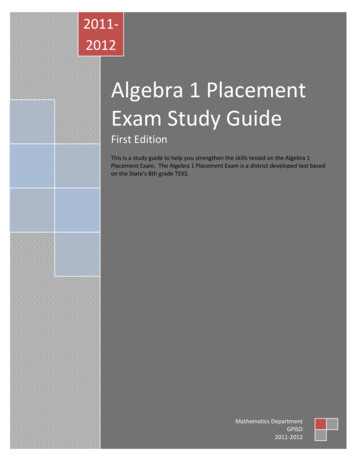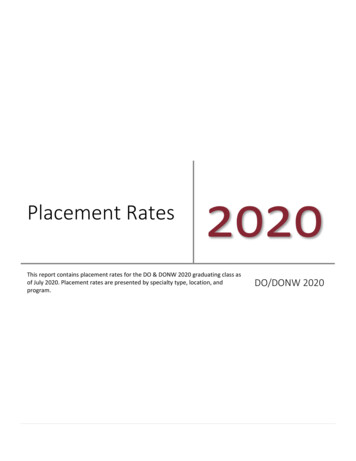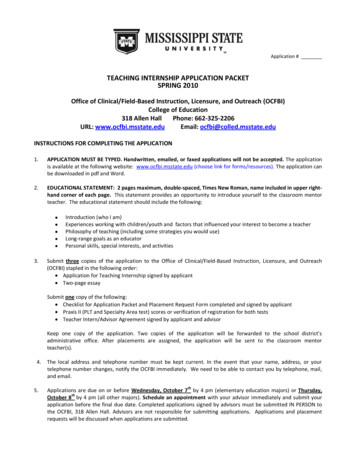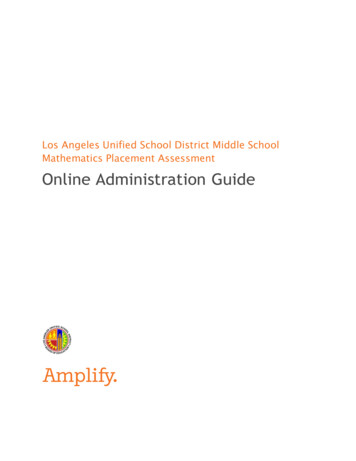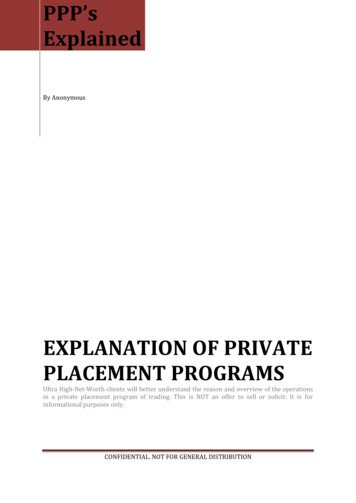
Transcription
PPP’sExplainedBy AnonymousEXPLANATION OF PRIVATEPLACEMENT PROGRAMSUltra High-Net-Worth clients will better understand the reason and overview of the operationsin a private placement program of trading. This is NOT an offer to sell or solicit: It is forinformational purposes only.CONFIDENTIAL. NOT FOR GENERAL DISTRIBUTION
EXPLANATION OF PRIVATEPLACEMENT PROGRAMSINTRODUCTION . 3TOPICS . 3THE BASIC REASONS FOR PPOPs . 3NORMAL TRADING vs. PRIVATE PLACEMENT. 5PROGRAM STRUCTURE . 8NON-SOLICITATION AND NON-DISCLOSURE . 9HOW BANKS AND BROKERS CAN PROFIT . 9PROJECTS . 10PROCESS SUMMARY . 10ANALYSIS OF RISK INVOLVED IN PPOP CONTRACTS. 11SCAMS . 15USE OF LAWYERS FOR ADVICE AND GUIDANCE . 16CONCLUSION . 17CONFIDENTIAL. NOT FOR GENERAL DISTRIBUTION
INTRODUCTIONThis document explains some of the obscure or unclear aspects of PrivatePlacement Opportunity Programs (PPOPs). PPOPs are also known underother names, such as Private Placement Programs (PPPs) or PrivatePlacement Investment Programs (PPIPs). This study is the result of severalyears of expert personal experience and testimony, and is explained from theviewpoints of both an client and a broker.TOPICSBefore tackling the topic of Private Placement Opportunity Programs, it isimportant to discuss the basic reasons for the existence of this business. Thisdiscussion includes the basic concept of what money is and how it is created,controlling the demand for money and credit, and the process of issuing a debtnote, discounting the note, and selling and reselling the note in arbitragetransactions.THE BASIC REASONS FOR PPOPSMONEY CREATIONFirst and foremost, PPOPs exist to “create” money. Money is created bycreating debt.For example: You as an individual can agree to loan 100 to a friend, with theunderstanding that the interest for the loan will be 10%, resulting in a total tobe repaid of 110. What you have done is to actually create 10, even thoughyou don't see that money initially.Don't consider the legal aspects of such an agreement, just the numbers.Banks are doing this sort of lending every day, but with much more money.Essentially, banks have the power to create money from nothing. Since PPOPsinvolve trading with discounted bank-issued debt instruments, money isCONFIDENTIAL. NOT FOR GENERAL DISTRIBUTION
created due to the fact that such instruments are deferred paymentobligations, or debts. Money is created from that debt.Theoretically, any person, company, or organization can issue debt notes(again, ignore the legalities of the process). Debt notes are deferred paymentliabilities.Example: A person (individual, company, or organization) is in need of 100.He generates a debt note for 120 that matures after 1 year, and sells this debtfor 100. This process is known as “discounting”. Theoretically, the issuer isable to issue as many such debt notes at whatever face value he desires – aslong as borrowers believe that he's financially strong enough to honour themupon maturity.Debts notes such as Medium Terms Notes (MTN), Bank Guarantees (BG), andStand-By Letters of Credit (SBLC) are issued at discounted prices by majorworld banks in the amount of billions of USD every day.Essentially, they "create" such debt notes out of thin air, merely by creating adocument.The core problem: To issue such a debt note is very simple, but the issuerwould have problems finding buyers unless the buyer "believes" that theissuer is financially strong enough to honour that debt note upon maturity.Any bank can issue such a debt note, sell it at discount, and promise to payback the full face value at the time the debt note matures. But would thatissuing bank be able to find any buyer for such a debt note without beingfinancially strong?If one of the largest banks in Western Europe sold debt notes with a face valueof 1M EURO at a discounted price of 800,000, most individuals wouldconsider purchasing one, given the financial means and opportunity to verifyit beforehand. Conversely, if a stranger approached an individual on the streetwith an identical bank note, issued by an unknown bank, and offered it for thesame sale price; most people would never consider that offer. It is a matter oftrust and credibility. This also illustrates why there's so much fraud and somany bogus instruments in this business.LARGE DEBTS' INSTRUMENTS' MARKETAs a consequence of the previous statements, there is an enormous dailymarket of discounted bank instruments (e.g., MTN, BG, SBLC, Bonds, PN)CONFIDENTIAL. NOT FOR GENERAL DISTRIBUTION
involving issuing banks and groups of exit-buyers (Pension Funds, largefinancial institutions, etc.) in an exclusive Private Placement arena.All such activities by the bank are done as "Off-Balance Sheet Activities". Assuch, the bank benefits in many ways. Off-Balance Sheet Activities arecontingent assets and liabilities, where the value depends upon the outcomeof which the claim is based, similar to that of an option. Off-Balance SheetActivities appear on the balance sheet ONLY as memoranda items. When theygenerate a cash flow they appear as a credit or debit in the balance sheet. Thebank does not have to consider binding capital constraints, as there is nodeposit liability.NORMAL TRADING VS. PRIVATE PLACEMENTAll trading programs in the Private Placement arena involve trade with suchdiscounted debt notes in some fashion. Further, in order to bypass the legalrestrictions, this trading can only be done on a private level. This is the maindifference between this type of trading and "normal" trading, which is highlyregulated. This is a Private Placement level business transaction that is freefrom the usual restrictions present in the securities market.Usually, trading is performed under the "open market" (also known as the"spot market") where discounted instruments are bought and sold withauction-type bids. To participate in such trading, the traders must be in fullcontrol of the funds, otherwise they lack the means buy the instruments andresell them. Also, there are fewer arbitrage transactions in this market, sinceall participants have knowledge of the instruments and their prices.However, in addition to the open market there is a closed, private marketwherein lies a restricted number of "master commitment holders". Theseholders are Trusts with huge amounts of money that enter contractualagreements with banks to buy a limited number of fresh-cut instruments at aspecific price during an allotted period of time. Their job is to resell theseinstruments, so they contract sub-commitment holders, who in turn contractexit-buyers.These programs are all based on arbitrage transactions with pre-definedprices. As such, the traders never need to be in control of the client's funds.However, no program can start unless there is a sufficient quantity of moneyCONFIDENTIAL. NOT FOR GENERAL DISTRIBUTION
backing each transaction. It is at this point the clients are needed, because theinvolved banks and commitment holders are not allowed to trade with theirown money unless they have reserved enough funds on the market,comprising unused money that belongs to clients, never at risk.The trading banks can loan money to the traders. Typically, this money isloaned at a ratio of 1:10, but during certain conditions this ratio can be as highas 20:1. In other words, if the trader can "reserve" 100M, then the bank canloan 1B. In all actuality, the bank is giving the trader a line of credit based onhow much money the trader/commitment holder has, since the banks won'tloan that much money without collateral, no matter how much money theclients have.Because bankers and financial experts are well aware of the open market, andequally aware of the so-called "MTN-programs", but are closed out of theprivate market, they find it hard to believe that the private market exists.ARBITRAGE AND LEVERAGEPrivate Placement trading safety is based on the fact that the transactions areperformed as arbitrage transactions. This means that the instruments will bebought and resold immediately with pre-defined prices. A number of buyersand sellers are contracted, including exit-buyers comprising mostly of largefinancial institutions, insurance companies, or extremely wealthy individuals.The issued instruments are never sold directly to the exit-buyer, but to a chainof clients. For obvious reasons the involved banks cannot directly participatein these transactions, but are still profiting from it indirectly by loaning moneywith interest to the trader or client as a line of credit. This is their leverage.Furthermore, the banks profit from the commissions involved in eachtransaction.The client's principal does not have to be used for the transactions, as it is onlyreserved as a compensating balance ("mirrored") against this credit line. Thiscredit line is then used to back up the arbitrage transactions. Since the tradingis done as arbitrage, the money (“credit line”) doesn't have to be used, but itmust still be available to back up each and every transactions.Such programs never fail because they don't begin before all actors have beencontracted, and each actor knows exactly what role to play and how they willprofit from the transactions. A trader who is able to secure this leverage isable to control a line of credit typically 10 to 20 times that of the principal.CONFIDENTIAL. NOT FOR GENERAL DISTRIBUTION
Even though the trader is in control of that money, the money still cannot bespent. The trader need only show that the money is under his control, and isnot being used elsewhere at the time of the transaction.This concept can be illustrated in the following example. Assume you areoffered the chance to buy a car for 30,000 and that you also find anotherbuyer that is willing to buy it from you for 35,000. If the transactions arecompleted at the same time, then you will not be required to “spend” the 30,000 and then wait to receive the 35,000. Performing the transactions atthe same time nets you an immediate profit of 5,000. However, you muststill have that 30,000 and prove it is under your control.Arbitrage transactions with discounted bank instruments are done in a similarway. The involved traders never actually spend the money, but they must bein control of it. The client's principal is reserved directly for this, or indirectlyin order for the trader to leverage a line of credit.Confusion is common because most seem to believe that the money must bespent in order to complete the transaction. Even though this is the traditionalway of trading - buy low and sell high – and also the common way to trade onthe open market for securities and bank instruments, it is possible to set uparbitrage transactions if there is a chain of contracted buyers.This is why client’s funds in Private Placement Programs are always safewithout any trading risk.HIGH YIELDCompared to the yield from traditional investments, these programs usuallyget a very high yield. A yield of 50%-100% per week is possible.For example: Assume a leverage effect of 10:1, meaning the trader is able toback each buy-sell transaction with ten times the amount of money that theclient has in his bank account. In other words, the client has 10M, and thetrader is able to work with 100M. Assume also the trader is able to completethree buy-sell transactions per week for 40 banking weeks (one year), with a5% profit from each buy-sell transaction:(5% profit/transaction)(3 transactions/week) 15% profit/weekAssume 10x leverage effect 150% profit.PER WEEK!CONFIDENTIAL. NOT FOR GENERAL DISTRIBUTION
Even with a split of profit between the client and trading group, this stillresults in a double-digit weekly yield. This example can still be seen asconservative, since first tier trading groups can achieve a much higher singlespread for each transaction, as well as a markedly higher number of weeklytrades.CLIENTSThe involved clients (program clients) are not the end-buyers in the chain.The actual real end-buyers are financially strong companies who are lookingfor a long term, safe investment, like pension funds, trusts, and insurancecompanies. Because they are needed as end-buyers, they are not permitted toparticipate "in-between" as clients. The client who participates in a PPOP isjust an actor in the picture along with many other actors (issuing banks, exitbuyers, brokers, etc.) who benefit from this trading. Usually, the client doesnot interact with others involved in the process.PROGRAM STRUCTURENormally, a trading program is nothing more than a pre-arranged buy/sellarbitrage transaction of discounted banking instruments. Theoretically, anclient with a large amount of funds (on the level of 100-500M USD) couldarrange his own program by implementing the buy/sell transaction forhimself; however, in this case he needs to control the entire process, initiatingcontact with the banks and the exit buyers at the same time. This is not asimple task, considering the restrictions in place.For a client it is much simpler (and usually more profitable) to enter aprogram where the trader and his trading group have everything in place (theissuing banks, the exit buyers, the contracts ready for the arbitragetransaction, the line of credit with the trading banks, all of the necessaryguarantees/safety for the client, etc.). The client needs only to agree with thecontract proposed by the trader, disregarding any other underlying issues.It is further advantageous for the client to enter a program with asubstantially lower amount of money and benefit from the line of creditoffered by the trading group.CONFIDENTIAL. NOT FOR GENERAL DISTRIBUTION
NON-SOLICITATION AND NON-DISCLOSUREAs a direct consequence of the PPOP’s environment where this business has totake place, a non-solicitation agreement has to be strictly followed by allparties involved. This agreement strongly influences the way the participantscan interact with each other. Sometimes non-solicitation agreements fosterscam attempts, due to the fact that at an early stage it is often difficult for theclients to recognize reliable sources to be in contact with.There is another reason why so few experienced people talk about thesetransactions: virtually every contract involving the use of these high-yieldinstruments contains very explicit non-circumvention and non-disclosureclauses forbidding the contracting parties from discussing any aspect of thetransaction for a specified number of years. Hence, it is very difficult to locateexperienced contacts who are both knowledgeable and willing to talk openlyabout this type of instrument and the profitability of the transactions in whichthey figure. This is a highly private business, not advertised anywhere norcovered in the press, and is closed to anyone but the best-connected, mostwealthy entities that can come forward with substantial cash funds.HOW BANKS AND BROKERS CAN PROFITBanks are not allowed to act as clients in such programs. However, they areable to profit indirectly in different ways. This fact permits some privatebrokers, trading groups, and clients to take part in this process that otherwisewould be a banking matter only. The assets coming from private clients arenecessary to start the process. These private, large funds are the mandatoryrequirement for the buy/sell transactions of banking debt instruments.Brokers are necessary to introduce the clients to the trading groups. Thus,each of the involved parties takes their part in the sharing of the benefits,commissions for banks and brokers and proceeds for trading groups andclients).CONFIDENTIAL. NOT FOR GENERAL DISTRIBUTION
PROJECTSThe purpose of this type of trading is to finance projects, not generatetremendous profits for the client. These may be for-profit or non-profit andcan be funded as a result of this trading.Since this type of trading generates such large amounts of money on themarket, measures must be taken to keep the inflation low. One way to do thisis to adjust the interest rates, but this usually has little or no effect. A betterway to minimize inflation is to let some of the profit be used for differentprojects that need funding, such as rebuilding infrastructure in regions of theworld that have experienced catastrophes or war.PROCESS SYNTHESISThe complete process involving the issuing of debt-notes, the arbitragetransactions, the programs, and the projects is a result of combined marketforces. Banks have a method of increasing their revenues and profits, clientsare able to finance different ventures, and borrowers are able to access loanfunds. There is a supply and demand for such instruments, and as long as thesupply and demand exists then also this kind of trading will exist.PROCESS SUMMARYThe following is a summary of the process involved for entering a PPOP:A client with a minimum of 100M applies for a Private PlacementOpportunity Program.This business is entirely private. To get access to these investment programs,the client needs to send his preliminary documentation to a broker whom theclient trusts to be in direct contact with the trading group. That means a ClientInformation Sheet, a copy of their passport, and a bank statement showing thebalance of funds being committed for trade. It is generally required that thebank statement be signed by two authorized bank officers to make it full bankresponsibility. There is no other way for the client to get contact with thetrading group.CONFIDENTIAL. NOT FOR GENERAL DISTRIBUTION
After the client has sent his own paperwork (their Passport, ClientInformation Sheet, and recent bank statement showing cash), the tradinggroup will investigate the applicant. If the response is positive, the programmanager in the trading group will contact or meet with the client. If theinvestigation is not favourable, the program manager will contact the brokerand tell him that the client did not qualify.During the contact with the client, the trader will explain the programterms/conditions to the client, and outline the guarantees and requirementsto start the program. The client will get instructions to open a new solesignatory bank account at the trading bank for transferring the funds there.The client will receive a contract which states the total gross yield, thepercentage of the gross profit reserved for projects, the percentage for thetrading group and the percentage for profit participation fees to be deductedfor brokers/intermediaries. The net return to the client will be wired toanother account that can be located in any bank worldwide. If the clientaccepts the contract, the contract is signed and the program is ready to start.The trader is now able to leverage the client's reserved money 10 times, and isnow able to back up the arbitrage transactions with that money, a credit linethat remains in the bank account that is screened before each arbitragetransaction. Trading now continues, and the profit is paid out per the contractterms to the client.The programs work with cash only or gold bullion. This fact means that theclient will only be accepted with liquid funds. Recent rulings by the G20prohibit the use of an asset other than cash or gold bullion in a bank vault. Aline of credit must be established and drawn down into an account at a bank,where it is lodged and blocked.ANALYSIS OF RISK INVOLVED IN PPOP CONTRACTSFinalizing PPOP contracts with clients can be a stressful process because ofproblems encountered along the way.FROM THE CLIENT'S SIDECONFIDENTIAL. NOT FOR GENERAL DISTRIBUTION
The applicant client will not be able to meet directly with the trader in thisbusiness. The main reason why there's a broker-intermediary chain isbecause the people in the trading groups have no time or interest in meetingall the people who are just fishing for information, and/or who fail to qualifybecause they don't have enough money, or have useless bank instruments.If you're a qualifying client, truly connected intermediaries/brokers should beable to place you in contact with a performing trading group. Don't attempt tofind a trader on your own: Most so-called traders in the financial world arenot involved in this kind of trading and are not educated to their existence.Those few traders who are keep a low profile and would never talk with aclient who hasn't been cleared. In fact they cannot until the client passes theinternational KYC (Know Your Customer) compliance.When it comes to cases of non-performance, the problem is usually on theclient side. The client doesn't qualify for a variety of reasons; he doesn't haveenough money, the bank is too small or is located in the wrong country, hecannot move his funds, etc.Oftentimes deals are killed because the broker and/or intermediary don'tunderstand the process, and inject themselves, more concerned about a feethan about allowing the two principals (Client and Trader) to interact withoutinterference.Some of the most common reasons why clients are never able to enter thiskind of trading are: They don't have enough money or workable assets. They don't have the money in an acceptable bank. They don't have full control of the money (or of the bank instruments). They don't have a good explanation of the origin of the money. They do not follow the required procedure. They do not collaborate enough with the Trading Group.CONFIDENTIAL. NOT FOR GENERAL DISTRIBUTION
They delay the delivery of documents or send fake or non-confirmeddocuments. Their identity cannot be confirmed. They are blacklisted or under investigation.Remember that the trading group does not have to give any explanation whythe client doesn't pass through the clearance.Clients should understand what is required to qualify: A minimum of 100 Million EURO or USD in cash located in a majorbank in Western Europe, USA, Canada, Hong Kong, Singapore orAustralia. Additionally, the money needs to be traceable with a noncriminal history. The client, or company if one is represented, should be clearlyidentified. Once cleared, clients are invited to the table, but their acceptance isnever guaranteed, regardless of their assets or prominence. The client himself must be the one and only person that the tradinggroup deals with. He is not allowed to let his lawyer or any otherperson perform or act on his behalf, brokers included. If the client doesnot speak English and needs assistance, then he must sign a LimitedPower of Attorney for a translator. The LPOA will only be accepted forcommunication purposes, and the must still sign all the documents.Clients who have the least amount of money are always placed last in thequeue. A client with 100M will get more attention than an client with 10M.Clients who have assets other than cash or AU bullion in a bank vault will alsoalways be placed last in the queue, if they are accepted at all. Assets otherthan cash or gold bullion must be monetized to provide cash for the tradingaccount.CONFIDENTIAL. NOT FOR GENERAL DISTRIBUTION
It is difficult for any client to ensure that he meets the right people; those fewintermediaries and brokers who know the process and who are working witha performing trading group. The best he can do is to educate himself and notbe lured by those who claim that their program will give the highest yield. Hemust also be patient, and trust the legitimate intermediary or broker. There isno way that the client will directly meet with the trade group before he hasbeen cleared.If for any reason the client is dissatisfied with the broker and/or intermediary,then another one can be obtained.These are some of the main risks the client can meet: Nothing will come out of the trade; no contract and no profit, justfrustration after weeks/months of waiting. Clients or their intermediaries and/or brokers are "shopping around"with client documents, which sooner or later will result in blacklisting. The client is told that he must move his funds out of his own control; toan escrow account, etc. The client is told that he must buy or lease a bank instrument for hismoney. In the worst-case scenario this instrument is a fake, orimpossible to use. The client is told that he must pay upfront fees, because a leverage of hisfunds must be done, or some bank instrument must be discounted, orbanking fees must be paid, etc. The upfront fees paid are lost, andnothing more will happen.FROM THE BROKER'S AND INTERMEDIARY'S SIDEThere is a common misuse of such terms as brokers, intermediaries, andfacilitators. The fact is, these are not official terms in banking or finance, butsuch terms are used within trading groups and in their communicationbetween each other. Although a broker or an intermediary can claim that theyare in direct contact with a person carrying that title, it is not a guarantee ofanything. Any person can fraudulently call himself a trader, or a commitmentCONFIDENTIAL. NOT FOR GENERAL DISTRIBUTION
holder, or whatever. And since such positions cannot be verified (at the firststage), such titles can be meaningless as seen from the clients' point of view.There is almost always a chain of trading group, a broker and intermediary,and client. This is for two reasons. Firstly, trading groups, brokers, andintermediaries are not allowed to solicit; the Client must start by asking forinformation.Secondly, this protects all parties involved with the trading group. Brokersmay work through several intermediaries, and vice versa intermediaries. Achain of more than one or two intermediaries connected directly between thetwo Principals, in general, is not acceptable to some program providers.A good broker should also screen the potential clients, filtering the mostpromising applicants and at the same time collecting from them the properdocumentation.In this way, the trading group receives workabledocumentation from the broker.The most common risks or problems that a broker, an intermediary or afacilitator can meet with in this business are: They may need to investigate dozens of clients before finding a qualifiedapplicant. They may discover the assets of client to be unworkable after weeks ormonths of processing. They may have difficulty qualifying themselves with new clientsbecause they cannot show any past performance or past contracts. Therelationship with the client is just a matter of trust at an early stage.There could be several levels involved for the intermediaries. The closest oneto the trading group (sometimes called also facilitator) is the most importantperson. This person should have a direct contact with the trading group. Anyother broker beneath the facilitator has a lower value in the hierarchy. Thebroker and/or the intermediary can have problems showing the client hislevel in the hierarchy at an early stage.SCAMSCONFIDENTIAL. NOT FOR GENERAL DISTRIBUTION
From time to time you may hear about scams (or potential scams) in the HighYield Investment Programs arena. One of the conditions that facilitate scamsin this business is due mainly to the non-solicitation environment and theprivate approach required that forces information to remain as purewhispered gossip ready to be expressed aloud at any time. That fact facilitatesa diffuse level of ignorance in this matter where scammers are in theirelement.Possible scams include: The intermediary asks for up-front fees (in a real situation no one willask for up-front fees to the client). You are asked to transfer the money into an escrow account not in fullcontrol of the client. You are asked to buy a bank instrument against the funds to start theprogram (that later will be discovered to be of no value). You are asked to pool the funds together with other little clients.The internet is now full of different money-making opportunities that promiseto return a high yield on the small client's money. In most cases suchprograms are Ponzi schemes (pyramid schemes). And even if a few might bemanaged by honest people who are trying to aggregate enough funds in orderto enter this kind of trading, they are doomed to fail. First there is theproblem with pooling a 100M minimum. In many countries, it is illegal topool money with promises of a high return. Factor in the problems with highnumbers of participants being managed, the trust factor, and clearance issues,trading may never begin.However, the main scams are usually made or attempted with small clientsthat never will qualify as PPOP clients. Usually, it is very rare that an honestclient with 100M can fall into this kind of trap. Larger clients are investmentsavvy and can utilize the knowledge of other financial e
All trading programs in the Private Placement arena involve trade with such discounted debt notes in some fashion. Further, in order to bypass the legal restrictions, this trading can only be done on a private level. This is the main difference between this type of trading "normal" trading, which is highly and regulated.
